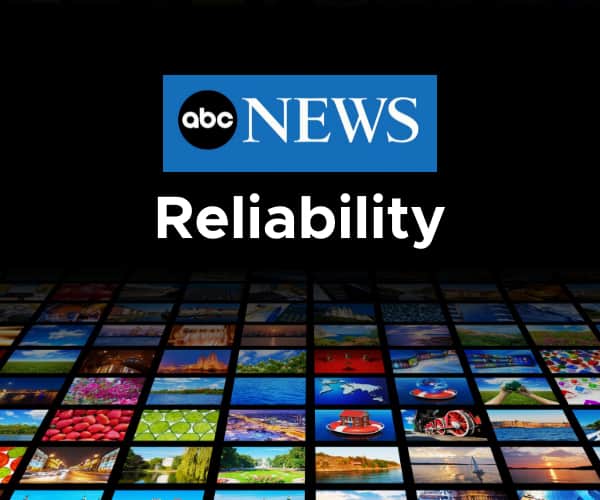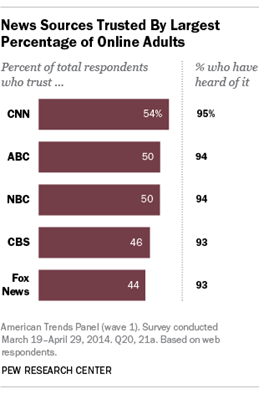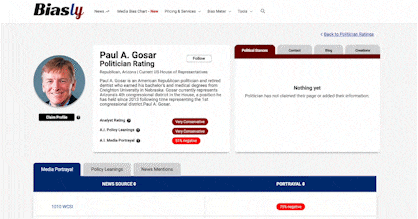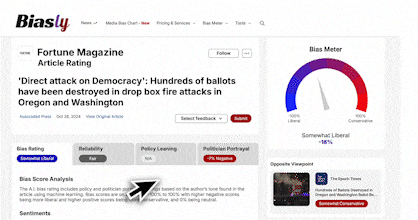
ABC News, or the American Broadcasting Company, was founded in 1945 in New York, New York. It quickly became one of America’s most prominent new sources, with its news channel’s viewership growing to 7.6 million in 2020. With so many Americans relying on ABC to get their news, some have criticized the company for putting politics over facts, accusing ABC of twisting the narrative to serve a liberal bias, an accusation they support by pointing to the liberal lean of ABC’s average audience member. In fact, 50% of those who said they’d heard of ABC News don’t trust it (see chart below). But is this really the case, or is ABC News able to strike a balance between reliable reporting and serving its own political agenda?

Source: Pew Research
Why Reliability Matters
Reliability refers to how factually accurate, or credible, a fact, or source, is. In this case, we’re taking a closer look at the overall reliability of ABC News as an entity and publisher. Reliability is important because a more reliable source is a more truthful source that can be trusted to give an accurate depiction of events without purposefully inserting or emitting facts to try and shape an audience’s perspective.
This is especially important in a mainstream media company like ABC News, precisely because so many people trust ABC as a major, if not their only, source of news. If audiences can’t trust the media they consume to report on events reliably, then they lose trust in the media as a whole.
So how do we measure a media company’s reliability?
We take a multitude of factors into account when trying to measure reliability, examining multiple articles for larger trends within the media source. Unreliability within articles often presents itself through less objective and more opinionated language that tends to place a greater focus on the author’s opinions than the facts of the story. Red flags for reliability include:
- Presence of subjective/opinionated language within articles
- Lack of cited sources, or use of sources with low degrees of credibility
- Unfounded claims that go beyond simply reporting on an issue
Aside from keeping an eye out for less factual reporting within articles, there are several positive indicators of reliability to keep an eye out for. Green flags for reliability include:
- Absence of subjective/opinionated language in articles
- Credible sources cited (e.g., neutral sources, .gov, .edu websites)
- Facts and statistics backed by multiple relevant outside sources
- Use of primary sources when possible (e.g., interviews, quotes)
- Information that remains consistent when researched with reputable sources
When trying to assess an article’s bias, one important measure we consider is an article’s accuracy, or whether an article is able to report factually on the claims they make. Two important factors to keep in mind when trying to determine how accurate an article is, are the article’s levels of selection bias and omission bias.
Selection bias occurs when stories and facts are selected or deselected, often on ideological grounds, to create a narrative that supports a particular news publisher’s political leanings. This can include things like only reporting on issues important to that particular political side, or only reporting on facts that support a certain political interpretation of a story. Omission bias, on the other hand, refers to when different opinions and political views regarding a situation are purposefully left out so that the reader is only exposed to the ideological perspective supported by the author. This can include things like only publishing quotes from those who support the political message or the article, or failing to include the reasoning given by those opposed to an action supported by the article.
It’s important to keep in mind these two types of biases when trying to assess an article’s level of accuracy, as authors making use of them often sacrifice reliability in doing so. Now let’s examine how bias can influence accuracy by looking at a few ABC News articles rated by Biasly.
How Does ABC Fare in its Reliability?
The political reliability index developed by Biasly objectively assesses news organizations’ accuracy and trustworthiness. ABC News’s overall Reliability Score has been rated as ‘Good’ by Biasly. This rating is a weighted average of two distinct scores: the Fact Analysis Score and the Source Analysis Score, each evaluating separate components of ABC News’s Reliability. When computing the Average Reliability of the article the Fact Analysis score is more heavily weighted. These ratings are as follows in the next two paragraphs:
ABC News’s Fact Analysis Score is ‘Good,’ which suggests readers can trust most of ABC News’s content online. The Fact Analysis score focuses more on the accuracy of claims, facts, and sources presented in the article and any hints of selection and omission bias, which we will discuss further in the article.
ABC News’s Source Analysis Score is ‘Fair,’ which suggests readers can trust some of the sources, links, and quotes provided by the news source. This score, which is based on A.I., focuses on assessing the quality of sources and quotes used including their number, lengths, uniqueness, and diversity.
However, since these scores are based on percentages and averages, individual articles could be more or less trustworthy depending on the context, author, and other factors. Our findings show that ABC News’s reliability is mostly but not all factual because they have retracted several stories in the past or had pieces that were not factual.
Let us analyze the supporting data for ABC News’s rankings and discuss what to watch out for while searching for trustworthy news sources.
Accuracy and Reliability in ABC News
If you check out ABC News’ page on the Biasly website, you can see the reliability and accuracy ratings given on some of their most recent articles. You’ll see that while there is some variance in reliability from article to article, the majority tend to stay closer to our average. You’ll also notice that changes in reliability are often associated with changes in bias, often due to the presence of selection and omission bias, meaning articles rated as being more politically biased tend to score lower in terms of reliability, and less biased articles score higher. Here Biasly uses a percentage rating scale spanning from -100 to 100 with more negative scores indicating more liberal biases, and more positive scores, more conservative biases.
These differences are present due to the way bias can influence some of the indicators of reliability listed above. A more biased article tends to include more subjective and emotional language and tends to place greater importance on proving an opinion. One article titled “Biden calls new GOP-passed Georgia law restricting voting access and ‘atrocity,’” was given an analyst bias score of Very Liberal and an author bias score of Very Liberal. This article received a significantly lower-than-average reliability score of “Fair.”
Let’s look at some of the facts reported in this article by comparing two quotes provided:
“[I]nstead of celebrating the rights of all Georgians to vote for winning campaigns on the merits of their ideas, Republicans in the state instead rushed through an un-American law to deny people the right to vote. This law, like so many others being pursued by Republicans in statehouses across the country is a blatant attack on the Constitution and good conscience,” Biden said in the statement.”
“There is nothing ‘Jim Crow’ about requiring a photo or state-issued ID to vote by absentee ballot – every Georgia voter must already do so when voting in-person. President Biden, the left, and the national media are determined to destroy the sanctity and security of the ballot box,” Kemp said in a statement.”
The first quote provided is from Joe Biden. The article includes a total of 8 direct quotes from Joe Biden throughout the article, selecting a variety of statements he made in opposition to the actions taken in Georgia. The second quote, however, from Georgia Governor Kemp is the only article in support of the voting legislation provided. These examples illustrate how selection and omission bias function, first through the selection of quotes in support of the article’s main point, and second in the omitting the majority of quotes opposed to it.
A more reliable article, on the other hand, focuses on objectively informing the reader first, before pushing any sort of agenda. Reliable articles use more neutral language and back their facts with credible sources. An article titled “House passes anti-Asian hate crimes bill, legislation awaits Biden’s signature,” received an analyst bias score of somewhat liberal and an author bias score of somewhat liberal. This article received a higher-than-average reliability score of “Excellent.”
This article, on the other hand, while still biased in the sense that it was given a more liberal rating, makes heavy use of outside sources to support the points being made. For example, when the reporting on a vote held by the House of Representatives a link to the official announcement is provided. As this link provides the reader with information reported directly from the House of Representatives it has a very high degree This pattern continues throughout the article, allowing it to overcome its partisan lean and maintain a high degree of reliability.
Analysis of ABC News Opinion Pieces
While bias in the form of selection and omission can be more or less present depending on the article in question, there is one type of journalism where bias on the part of the author is universal; the opinion piece. Whereas typical factual reporting focuses on the facts of any particular event, the opinion piece is published to convey the author’s personal opinion on a topic. These pieces are often subjective and made to persuade an audience of a particular point of view, making them less accurate and reliable as a whole.
Let’s look at an opinion piece published by ABC News titled, “It’s time to overhaul our gun violence prevention system: Opinion.
“America is in the throes of an epidemic of mass-casualty gun violence, and the toxic political environment in Washington has crippled efforts to curb the growing threat.”
Here the author establishes their argument clearly, building off the claim made in the article’s title and stating that not only is gun violence a salient issue in America, but that the current systems in place to control it are flawed. The rest of the article will serve to support this argument, through the use of selection and omission bias, in the form of the arguments shown to the reader, and through a multitude of unsupported claims.
“This is not punitive; it is designed to protect the person in need — as well as the family and community around them.”
This line serves as a prime example of language commonly used in opinion pieces. Here the author states their opinion, that restricting an individual’s access to a firearm is not punitive, and argues that this measure would help control gun violence. The author does not, however, provide any studies or statistics supporting the effectiveness of this program to support this claim, a pattern present throughout the article.
Additionally, while the article focuses largely on the potential benefits of the proposed framework, through the selection of arguments supporting the point, all opposing arguments are omitted completely, biasing the article heavily in the author’s favor at the loss of overall accuracy and reliability.
So is ABC News Reliable?
While it would be far easier for everyone if we were able to give a solid “yes” or “no” to this question, the answer when it comes to reliability is often it depends. While ABC News overall has a perfectly reasonable degree of reliability, reliability can vary heavily between articles, as you saw in our examples above. While one article might make use of credible sources to construct a strong reliable narrative, another might throw out unfounded claims left and right.
While some articles do a great job managing their objectivity and neutrality by providing credible and factual reporting, others fall short of the bar. This highlights the importance of learning to identify the red and green flags of reliability and of making use of an indicator like Biasly’s News Check chrome extension to analyze the bias and reliability scores of any given article. You’ll find that as you continue to see how different articles are rated, you can gain a clearer understanding of how to spot markers of reliability and accuracy issues within an article, allowing you to improve your own media literacy.
Disclaimer: Pew Research Center bears no responsibility for the analyses or interpretations of the data presented here. The opinions expressed herein, including any implications for policy, are those of the author and not of Pew Research Center.

























